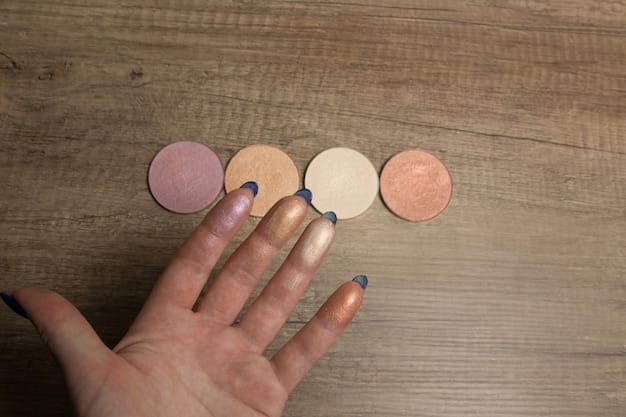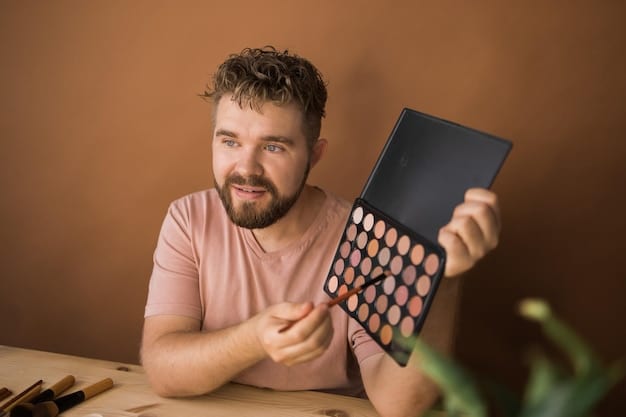How to Choose the Right Concealer Shade for Men in 2025

Choosing the right concealer shade in 2025 requires understanding your skin’s undertones, testing shades in natural light, and considering the specific concerns you aim to address, such as dark circles or blemishes, for a seamless, natural-looking finish.
Finding the perfect concealer shade can be a game-changer for any man looking to enhance his appearance. In this guide, we’ll explore how to choose the right concealer shade for your skin tone: a 2025 guide for men, ensuring a flawless and natural look.
Understanding Your Skin Tone
Before diving into the world of concealers, it’s essential to understand your skin tone. Identifying whether you have a fair, light, medium, tan, or deep skin tone is the first step in finding the right concealer.
This knowledge will help you narrow down your options and make the selection process much easier. Let’s break down how to figure out your skin tone.
Determining Your Skin Tone
To determine your skin tone, observe your skin in natural light. Here are some basic characteristics of each skin tone category:
- Fair: Very light skin that burns easily in the sun.
- Light: Light skin that can tan but still burns with prolonged sun exposure.
- Medium: Skin that tans easily and rarely burns.
- Tan: Skin that is naturally dark and tans very easily.
- Deep: Richly pigmented skin that rarely burns and is highly resistant to sun damage.
Once you’ve identified your overall skin tone, you can move on to the next crucial step: understanding your undertones.
Understanding your skin tone is the foundation for choosing the right concealer. With this knowledge, you can refine your search and focus on shades that complement your natural complexion, leading to a more seamless and natural appearance.

Identifying Your Undertones
Undertones are the subtle hues beneath the surface of your skin. They can be warm, cool, or neutral, and understanding them is key to selecting a concealer that blends seamlessly with your complexion.
Concealers with the wrong undertone can look ashy or orange, so let’s explore how to pinpoint your undertones.
The Vein Test
One simple way to determine your undertone is by looking at the veins on your wrist. Here’s how to interpret the results:
- Blue or purple veins: Indicate cool undertones.
- Green veins: Suggest warm undertones.
- Blue-green veins: Imply neutral undertones.
The Jewelry Test
Another method is to observe how your skin looks with different types of jewelry:
- Silver jewelry: Tends to look better on those with cool undertones.
- Gold jewelry: Complements warm undertones.
- Both silver and gold: Look equally good on neutral undertones.
Warm, Cool, or Neutral?
Understanding whether you have a warm, cool, or neutral undertone is essential for selecting the right concealer. This ensures that the concealer blends seamlessly with your skin, creating a flawless look.
Once you’ve determined your undertone, you can use this information to select concealers with matching undertones, avoiding any unnatural or mismatched appearances.
Choosing the Right Concealer Shade
Now that you know your skin tone and undertones, it’s time to choose the right concealer shade. The goal is to find a shade that neutralizes imperfections without being too light or too dark.
Here are some practical tips to help you find the perfect match, ensuring a natural and effective look.
For Under-Eye Circles
To correct under-eye circles, choose a concealer that is one to two shades lighter than your skin tone, but with the same undertone:
- Cool undertones: Look for concealers with pink or peach undertones to counteract blueish circles.
- Warm undertones: Opt for concealers with yellow or golden undertones to brighten the area.
- Neutral undertones: Choose a concealer that is a true match or slightly lighter.
For Blemishes and Redness
For blemishes and redness, select a concealer that matches your skin tone exactly. This helps to conceal the imperfection without drawing attention to it:
- Green-tinted concealers: Are effective for neutralizing redness caused by acne or rosacea.
- Ensure full coverage: To completely hide the blemish without needing multiple applications.
The Importance of Natural Light
Always test concealer shades in natural light. Artificial light can distort colors, leading to a mismatch. Apply a small amount of concealer to your jawline and check the color in daylight to ensure it blends seamlessly with your skin.
Choosing the right concealer shade involves matching your skin tone and undertones, and understanding the purpose of the concealer. By following these tips and testing shades in natural light, you can find the perfect concealer to enhance your appearance.

Understanding Different Concealer Formulas
Concealers come in various formulas, each with its own set of benefits. Understanding these different types can help you choose the right one for your specific needs and skin type.
Let’s explore the most common concealer formulas and their ideal uses, ensuring you select the best product for your desired look.
Liquid Concealers
Liquid concealers are versatile and work well for most skin types. They offer buildable coverage and a natural finish:
- Hydrating formulas: Are suitable for dry skin.
- Matte formulas: Are best for oily skin.
Cream Concealers
Cream concealers provide medium to full coverage and are ideal for covering blemishes and dark spots. They are best suited for normal to dry skin:
- Avoid heavy application: To prevent creasing and a cakey appearance.
Stick Concealers
Stick concealers offer the most coverage and are great for spot concealing. They are easy to apply but can be heavy, so use them sparingly:
- Best for oily or combination skin: Due to their drier consistency.
Choosing the Right Formula for Your Skin Type
Selecting the right concealer formula is as important as choosing the right shade. Considering your skin type ensures that the concealer not only covers imperfections but also maintains healthy-looking skin.
By understanding the benefits of each formula, you can make an informed decision and achieve a flawless finish that caters to your individual skin needs.
Application Techniques for a Natural Look
Applying concealer correctly is just as important as choosing the right shade and formula. The goal is to create a natural, seamless look without any obvious lines or patches.
Mastering these techniques will ensure that your concealer enhances your appearance subtly and effectively, leaving you looking refreshed and confident.
Using the Right Tools
The right tools can make a significant difference in how your concealer looks. Here are some options:
- Concealer brush: For precise application and blending.
- Makeup sponge: For a seamless, airbrushed finish.
- Fingertips: For warming up the product and pressing it into the skin.
Blending is Key
Proper blending is essential for a natural look. Whether you use a brush, sponge, or your fingertips, ensure that the edges of the concealer are seamlessly blended into your skin. Avoid harsh lines or visible product buildup.
- Dampen your sponge: For a smoother application.
- Use gentle tapping motions: To blend without removing the product.
Setting the Concealer
To prevent creasing and ensure long-lasting wear, set your concealer with a light dusting of translucent powder. Use a small brush to apply the powder only to the concealed areas.
Mastering the right application techniques will elevate your concealer game. By using the right tools, blending properly, and setting the concealer, you can achieve a natural and long-lasting finish that enhances your appearance subtly and effectively.
Common Concealer Mistakes to Avoid
Even with the right shade and formula, mistakes can happen during concealer application. Knowing what to avoid can help you achieve a flawless, natural look every time.
Here are some common concealer mistakes and how to prevent them, ensuring you always put your best face forward.
Choosing the Wrong Shade
Selecting a concealer shade that is too light can make you look ashy, while a shade that is too dark can highlight imperfections. Always test the shade in natural light and choose one that closely matches your skin tone or is slightly lighter for under-eye circles.
Applying Too Much Product
Applying too much concealer can lead to a cakey and unnatural appearance. Start with a small amount and build coverage as needed. Less is often more when it comes to concealer.
Skipping Moisturizer
Dry skin can cause concealer to crease and look patchy. Always moisturize your skin before applying concealer to create a smooth base. This is especially important for the under-eye area.
Avoiding these common mistakes and paying attention to your application technique can significantly improve your concealer results. By choosing the right shade, applying the correct amount, and prepping your skin properly, you can achieve a flawless and natural look every time.
| Key Point | Brief Description |
|---|---|
| 🎨 Skin Tone | Determine if you are fair, light, medium, tan or deep. |
| 🌡️ Undertones | Identify your undertones as warm, cool, or neutral. |
| 💡 Shade Matching | Choose a shade that neutralizes without being too light or dark. |
| ☀️ Natural Light | Always test shades in natural light to ensure a seamless blend. |
Frequently Asked Questions
▼
Check the color of your veins on your wrist. Blue or purple veins suggest cool undertones, green veins indicate warm undertones, and blue-green veins imply neutral undertones.
▼
Matte liquid concealers or stick concealers are generally best for oily skin. These formulas tend to be less emollient and can help control shine while providing coverage.
▼
For under-eye circles, choose a concealer that is one to two shades lighter than your skin tone. This helps brighten the area and counteract any darkness present under the eyes.
▼
Use a damp makeup sponge or a concealer brush to blend the edges of the concealer seamlessly into your skin. Gentle tapping motions work best to avoid removing the product.
▼
Creasing can occur when concealer settles into fine lines. Setting the concealer with a light dusting of translucent powder and moisturizing beforehand can help prevent this issue.
Conclusion
Choosing the right concealer shade is vital for achieving a natural and polished look. By understanding your skin tone, identifying your undertones, and selecting the appropriate formula and shade, you can confidently enhance your appearance and address any skin concerns with ease.





